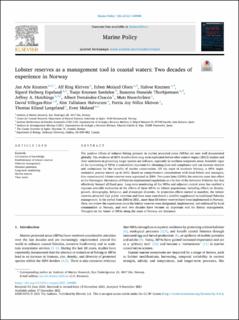| dc.contributor.author | Knutsen, Jan Atle | |
| dc.contributor.author | Kleiven, Alf Ring | |
| dc.contributor.author | Olsen, Esben Moland | |
| dc.contributor.author | Knutsen, Halvor | |
| dc.contributor.author | Espeland, Sigurd Heiberg | |
| dc.contributor.author | Sørdalen, Tonje Knutsen | |
| dc.contributor.author | Thorbjørnsen, Susanna Huneide | |
| dc.contributor.author | Hutchings, Jeffrey | |
| dc.contributor.author | Chacon, Albert Fernandez | |
| dc.contributor.author | Huserbråten, Mats Brockstedt Olsen | |
| dc.contributor.author | Villegas-Ríos, David | |
| dc.contributor.author | Halvorsen, Kim Aleksander Tallaksen | |
| dc.contributor.author | Kleiven, Portia Joy Nillos | |
| dc.contributor.author | Langeland, Thomas Kiland | |
| dc.contributor.author | Moland, Even | |
| dc.date.accessioned | 2022-06-17T07:49:20Z | |
| dc.date.available | 2022-06-17T07:49:20Z | |
| dc.date.created | 2022-03-21T08:35:27Z | |
| dc.date.issued | 2022 | |
| dc.identifier.citation | Marine Policy. 2022, 136 . | |
| dc.identifier.issn | 0308-597X | |
| dc.identifier.uri | https://hdl.handle.net/11250/2999207 | |
| dc.description.abstract | The positive effects of reduced fishing pressure in marine protected areas (MPAs) are now well documented globally. Yet, evidence of MPA benefits from long-term replicated before-after control-impact (BACI) studies and their usefulness in protecting target species are still rare, especially in northern temperate areas. Scientific rigor in the monitoring of MPAs is considered important for obtaining trust and compliance and can increase interest and enthusiasm for the benefits of marine conservation. Off the coast of southern Norway, a MPA imple- mentation process started up in 2002. Based on comprehensive consultations with local fishers and managers, four experimental lobster reserves were appointed in 2004. Two years later (2006), the reserves came into effect as the Norwegian Directorate of Fisheries implemented regulations as a by-law of the Saltwater Fisheries Act that effectively banned all fixed gear. Long-term monitoring of the MPAs and adjacent control areas has enabled a rigorous scientific evaluation of the effects of these MPAs on lobster populations, including effects on density, growth, demography, behavior, and phenotypic diversity. As protection effects started to manifest, the lobster reserves attracted high public attention and were soon considered a credible supplement to traditional fisheries management. In the period from 2002 to 2021, more than 50 lobster reserves have been implemented in Norway. Here, we review the experiences since the lobster reserves were designated, implemented, and embraced by local communities in Norway, and over two decades have become an important tool for fishery management. Thoughts on the future of MPAs along the coast of Norway are discussed. | |
| dc.language.iso | eng | |
| dc.title | Lobster reserves as a management tool in coastal waters: Two decades of experience in Norway | |
| dc.title.alternative | Lobster reserves as a management tool in coastal waters: Two decades of experience in Norway | |
| dc.type | Peer reviewed | |
| dc.type | Journal article | |
| dc.description.version | publishedVersion | |
| dc.source.pagenumber | 9 | |
| dc.source.volume | 136 | |
| dc.source.journal | Marine Policy | |
| dc.identifier.doi | 10.1016/j.marpol.2021.104908 | |
| dc.identifier.cristin | 2011225 | |
| cristin.ispublished | true | |
| cristin.fulltext | original | |
| cristin.qualitycode | 1 | |
